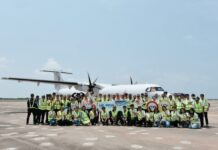

The air cargo industry has had a weak year and is below the peak at the end of 2014, though recovery in the Eurozone is the source of optimistic, the International Air Transport Association (IATA) says.
In its cargo chartbook, IATA says global economic growth has been lower than expected in 2015, meaning air cargo performance has been weak. Between January and October, freight tonne kilometres (FTK) increased by 2.6 per cent, much of it was caused by the US West coast seaport strike in the first quarter causing extra demand for airfreight. In October, FTKs were up 0.5 per cent year-on-year, and below the peak seen in December 2014.
The association says: “A tough global economic environment and feeble world trade have subdued air cargo demand. Emerging markets have struggled – a slowdown in China has sent commodity exporters wobbling. Advanced economies continue to expand at a healthy pace although slower than expected.”
“Looking ahead to Q4 and 2016, air cargo demand will continue to come under strain but a stronger recovery in the Eurozone – a key market – can be a source of optimism.”
Certain trade lanes have seen better year-on-year (YOY) results than others. Traffic to North America is generally strong, particularly from the Middle East, where it increased by 23.6 per cent in September, but it has been falling from April, when it was 35.2 per cent YOY. South America has been struggling, internally it declined by 10.3 per cent YOY in September, while North America to South America was down 5.8 per cent.
IATA says capacity has increased mainly because of deliveries and aircraft being taken out of storage, though in-storage capacity has remained relatively high.
IATA comments: “Q3 saw a significant increase in delivery of widebody freighter capacity. Furthermore, the pace of retirement of older aircraft has continued to slow, with retirements in Q3 coming nearly to a complete halt.”
International load factors have been weak, with IATA stating in other reports it has published that they are a lows not seen since mid-2009. It says on major trade lanes seeing declines capacity has exceeded FTK growth.
It says: “Lower load factors are in part expected as carriers optimise operations under lower oil prices. However, the synchronised dip in both freighter utilisation and load factors, also point to underlying weakness in the demand environment.”










